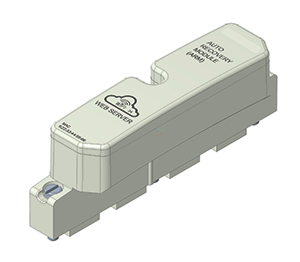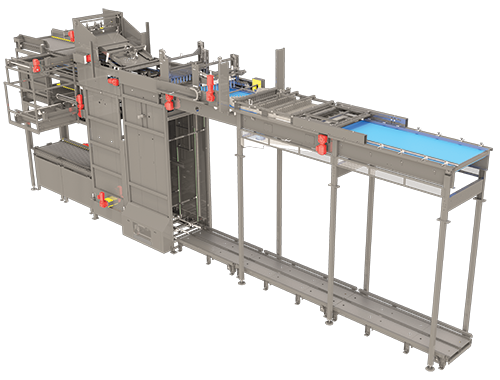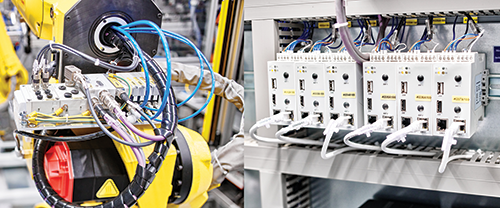Principles built around the Industrial Internet of Things (IIoT) have guided the automation industry’s rapid adoption and mainstreaming of many production systems. These systems are aligned with the concepts for digital transformation—including intelligent, networked production systems and components that leverage smarter information and communications technology.
As this evolutionary process builds momentum, some people may think proven manufacturing technologies such as pneumatics could be considered “outdated” or even “old-fashioned.” However, pneumatic technologies, including those that drive control valves, continue to evolve and incorporate sensors, industrial network interfaces, wireless technology and complex digital control features that make them well-suited for use in the emerging IIoT-driven production systems.
EVOLUTION OF TECHNOLOGY
Control of pneumatic valves and monitoring of cylinder position sensors originally was achieved through discrete wiring: Each programmable logic controller (PLC) output was individually wired to a solenoid valve coil and triggered separately. Position sensors on cylinders were wired back to the PLC’s input card. Such systems were expensive and time-consuming to install.
With the creation of plug-in valves and manifolds, these systems evolved into a more practical solution in which all the solenoid valve connections to the PLC input/output (I/O) cards could be achieved with a single cable and terminated by a multi-pin connector. This meant that, with one cable run, dozens of individual wires could be replaced easily, which reduced wiring costs for pneumatic valve control purposes significantly.
Although these plug-in valves reduced parts and labor costs for individually wiring each solenoid coil, they did not incorporate diagnostic feedback and other operational information that can be useful. Capturing that additional information would require separate sensors wired back to the PLC I/O cards to measure and verify correct functionality. This functionality data could include cylinder position, spool position, pressure, flow and other useful information.
As automation systems gained sophistication, fieldbus (industrial network) communications connectivity became more prevalent. This connectivity was implemented using a variety of industrial network protocols such as Profibus, Sercos and Ethernet-based fieldbus technologies. The solution offered additional cost savings and the opportunity for the PLC to both control valves and monitor sensors and devices exchanging I/O data via one, low-cost communication cable (without needing local I/O cards). Pneumatic valve manifolds began incorporating both fieldbus interfaces and I/O capability to provide complete pneumatic valve packages that were more versatile and engineered to be integrated easily with smarter, more sophisticated automation platforms.
The integration of these communications components on the valve manifolds, along with newer, lightweight polymer materials for construction and ingress protection from water and dust, also made it possible to locate the valve manifold closer to the system or actuators being controlled without the need for an enclosure. Machine builders now could more easily install valves on end effectors, robot arms and other working components, thereby locating the valve closer to pneumatically controlled devices. This configuration has several advantages: Besides decreasing the amount of tubing needed to connect the valves and cylinders driving the equipment, the pneumatic system can be optimized, leading to quicker response times and increased throughput for motion sequences.
INTEGRATING PRESSURE REGULATION
Advances in valve technology, performance and versatility took a major step forward when electropneumatic control capabilities were integrated into the valve manifold. A basic pneumatic valve is just a simple, directional control valve: An electric signal is sent to shift the valve spool, and the air is directed out of one port or the other. Conversely, electropneumatic (E/P) pressure-regulating valves, also called E/P converters, do not simply provide directional control; they also can provide a range of pressures proportional to the analog voltage or current of the signals the device receives from the PLC’s analog output card.
As seen with valve manifolds, strides also were made with proportional regulators. New technologies allowed these devices to be controlled more accurately using digital signals and allowed the integration of fieldbus connectivity. This meant that the machine’s PLC could easily and accurately send parameters to control valve and cylinder pressures dynamically, optimizing force and pressure requirements for the production system.
This advanced level of pneumatic control—intelligently combining both directional and pressure control—elevates the value and versatility of pneumatics for a wide range of automation applications. It allows greater, more precise and optimized control in the manufacturing process by ensuring good end-point accuracy and repeatability.
An example of how this works is electropneumatic control used in welding systems for automated manufacturing of engine starters. In this application, a pre-mounted armature is transported on workpiece pallets, aligned for position detection and brought into position for welding by pneumatically driven grippers. After welding, additional grippers return the armatures to workpiece pallets, which transport them to the next step in production.
Electropneumatic pressure regulators, combined with an advanced valve manifold with integrated fieldbus communication, optimize the diffusion welding processes with dynamically controlled pressure that can be precisely tailored to the application. At the same time, intelligence built into the manifold monitors and documents all the valve’s functions, controlling the grippers for an enhanced level of quality control and process tracking. An added advantage of using digital E/Ps here is energy efficiency can be optimized by supplying only the required pressure “on-the-fly” to perform a specific task, rather than using the highest pressure for all tasks. For example, an application may require a cylinder to extend at 80 psi, but the return can be at 30 psi to save energy. Using digital E/Ps, the machine builder can program these parameters into the system.
ENHANCING MONITORING AND CONTROL
One of the key goals of digital transformation in manufacturing is to gather actionable information that allows for more sophisticated and optimized control of every single step in a production process. Companies building components for automobiles, for example, want to know exactly the force, pressure and position of a cylinder driving an actuator that’s placing a bearing in a device. They also want that sequence documented so that 50,000 parts later, they know it was manufactured with the exact same precision as the first part.
If there is deviation in the data points the pneumatic devices generate as they operate, that data can indicate issues. Those issues can be with the actual device or include problems such as pressure loss in the air supply system, improper manufacturing of the bearings placed or actuators that are losing synchronization with the devices feeding the bearings. These issues can spring from component degradation and a need for maintenance.
The intelligence built into pneumatic valve systems provides new opportunities for monitoring and control. If a valve is rated to provide a proper operating life of 120 million cycles, when it reaches 100 million cycles, a well-designed predictive maintenance system can go into effect. That system can capture and use the data to either conduct an inspection and maintenance action or implement an automated purchasing request for a replacement device—before the unit actually fails.
As pneumatics become more intelligent, they are generating additional data points across the production systems where they are used—diagnostics, usage statistics and lifetime data are a few examples. This data has the most value when used to manage production systems more efficiently, control energy consumption and maximize uptime.
However, all this data from intelligent devices and subsystems has the potential to overwhelm the machine control network and affect control performance. Some pneumatics component manufacturers are offering smart pneumatic monitoring “gateways” or “hubs” that aggregate and organize pneumatic performance data and deliver it through separate, parallel pathways to plant management systems so the control network is not affected. These hubs can be independent of the process control architecture using OPC Unified Architecture, MQ Telemetry Transport, HyperText Transfer Protocol or email pathways to deliver alerts and data on both system-level and device-level performance.
With advancements in wireless communication, manufacturers also can offer device-level analytics to be captured and alarms transmitted via a Wi-Fi connection. The benefits of critical diagnostics information or key commissioning capabilities can become difficult to realize when a pneumatic valve system is mounted high in the air or deep inside a machine. However, manufacturers have also created easy access to the robust diagnostics and commissioning features of certain fieldbus platforms via a mobile website that can be used on phones, tablets and laptops with Wi-Fi capability without the need to install an application.
Pneumatic valve systems designed for digital transformation now incorporate features and technology that provide a new level of precision control for pneumatic-driven actuators and applications. Because of more advanced electronics within valve system control modules, designers can now incorporate proportional–integral–derivative (PID) controllers for pneumatic positioning applications that automatically apply accurate and responsive correction to a control function.
With these high-tech pneumatic capabilities, not only is it possible to provide more precise system end-point motion accuracy but, in conjunction with the PLC, it’s also possible to switch from position control to force control in real time and fine-tune motion sequences for very high levels of automation, product throughput, reliability and repeatability.
SMARTER PNEUMATIC VALVES
Pneumatic valves have been steadily evolving to help OEMs and end users make full use of pneumatic technology in their automation systems. In addition, many pneumatics technology providers have substantially upgraded their online configuration and ordering tools to make getting components that machine builders need efficient and easy even with short turnarounds.
These tools simplify what was once a time-consuming process of ordering multiple elements that make up the valve system—sub-bases, mountings and electronics, as well as the valves themselves. Now, these online configurators make it easy to order a valve assembly by selecting the fieldbus interfaces, integrated I/O modules and other features, complete with CAD drawings as part of the package without needing to know part numbers or system nuances. These tools enable both OEMs and end users to get a complete configuration in a condensed and more reliable purchasing process.
Leveraging the power of both electronics and modular, cutting-edge technology, pneumatic valves as part of a complete intelligent pneumatics motion and control platform provide a cost-effective, versatile technology option. That option can be used for a wide range of digital transformation initiatives for automation and manufacturing applications.
MARCHELLE FORISH is a product marketing manager, Valves and Valve Systems for Fluid and Motion Control at Emerson. She has more than 25 years of experience working in fluid power. Reach her at Marchelle.Forish@Emerson.com.
RELATED CONTENT
-
Operational Basics of Safety Valves
These spring-loaded valves provide overpressure protection for downstream equipment.
-
Pinch Valves: An Uncomplicated Valve With an Important Purpose
Used in on/off or throttling applications, choosing the right style pinch valve depends on the application.
-
An Introduction to Axial Flow Check Valves
Check valves are self-actualizing devices that respond to both pressure and flow changes in a piping system.














 Unloading large gate valve.jpg;maxWidth=214)